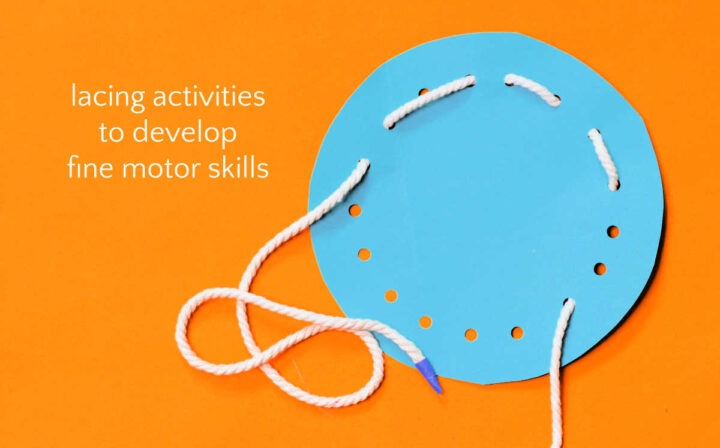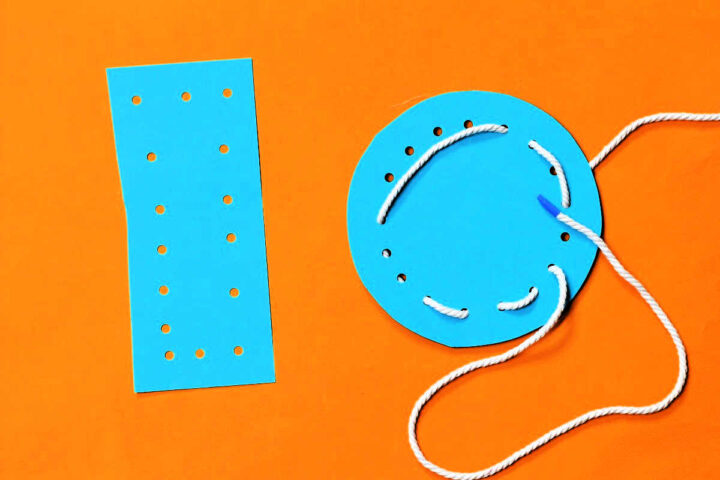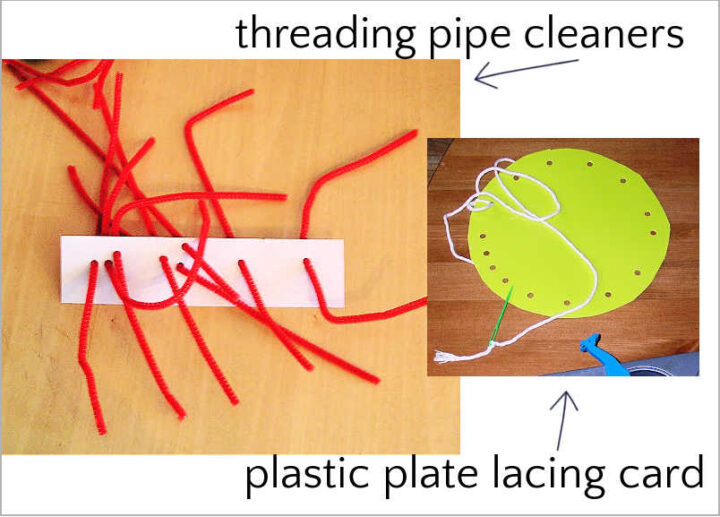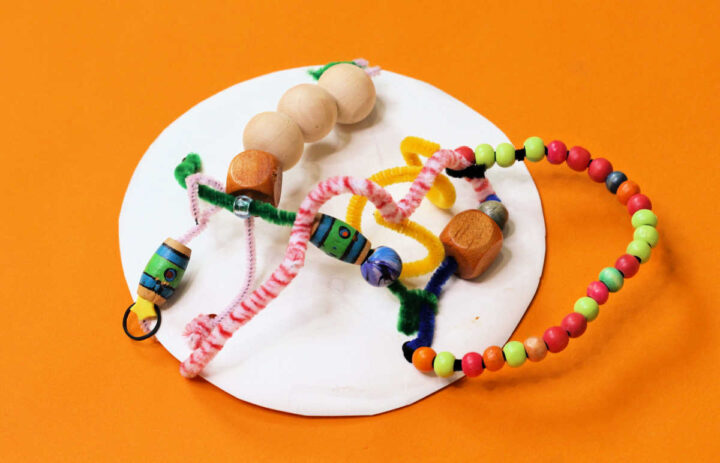These good ideas for lacing activities are an easy way to incorporate fine motor work at home with your your toddler or preschool. Even if your child doesn't require occupational therapy for fine motor delays or deficiencies, adding these lacing activities to their independent play time at home has many benefits.
Lacing activities help develop fine motor skills like the tripod grasp, pincer grasp and finger dexterity, which are necessary for handwriting and actions like doing up buttons and tying shoes. Like stacking activities, they also improve motor planning, bilateral coordination skills, and visual perception abilities.
In addition, working with lacing cards, tying laces and other types of actions improve concentration skills and develop patience, which all parents will appreciate!

Note: this post contains affiliate links that may earn commission from qualifying purchases.
DIY Lacing Activities
You may be surprised at all the ways you can to put together some lacing or threading activities for your child!
Threading materials you may have at home:
- shoe laces
- ribbons
- yarn
- string or twine
- pipe cleaners
- cording
- chopsticks or wooden dowels
Objects that can be threaded:
- cut up paper rolls (see our paper roll lacing idea!)
- cut up sections of pool noodles
- straws, or cut pieces of straws, either paper or plastic
- large beads
- large buttons
- hollow pasta like ziti noodles
- washers (hardware)
As you can see, lacing activities can be beneficial without being fancy. Provide some of the items in the lists above to your toddler or preschooler and demonstrate how lacing works.
Provide interesting and different combinations. Some ideas include threading pipe cleaners through paper holes, toothpicks through colander holes, pasta on chopsticks, washers onto bolts, beads on a string.

You might offer items in a designated basket during free play time, or give the materials to your child when they are sitting at the table. You could even make it a parent-child activity by stringing beads together. One afternoon, my son and I make this prism mobile which required stringing beads and crystal prisms on colored thread!
DIY Lacing Cards
Lacing cards are often part of a Montessori or preschool curriculum. You can buy lacing cards, but they are not hard to make at home, especially as you likely have everything you already need!
The lacing card has two parts. First, you'll need a base that has holes punched in it. Second, you'll need the laces.
Materials for DIY Lacing Cards
For the base you can use:
- cardboard. Thin board like that from a cereal box will be easier to punch holes into.
- foam sheets
- card stock or paper. Although you can get away with using regular paper in a pinch, the heavy weight of card stock is better.
- paper plates, or plastic plates
- thin mat board
- plastic berry basket
Other materials:
- hole punch
- scissors (optional)
- masking tape (optional)
- cookie cutters (optional)

How to Make Lacing Cards
You can make a basic lacing card simply by using the hole punch to places holes on the edge of your sturdy base material.
To make the lacing material easier to thread, wrap the end in a piece of masking tape.
Be sure your lace is long enough to go in and out of every hole, with extra, so that your child can thread the lace across the card in a variety of ways before running out of length.
Lacing card variations:
For lacing shapes, cut cards into circles, squares, triangles, etc.
You can create alphabet lacing cards by cutting cards in the shape of letters, although this is a more involved project and you may find that if you really want alphabet lacing cards, it may be worthwhile to purchase alphabet lacers like these.
MORE: Alphabet clothespin activity for fine motor skills

If desired, use cookie cutters to trace shapes onto your base material, and cut out. This way you can easily make fancy shapes if you have cookie cutters in the shape of items like dinosaurs, flowers, butterflies, gingerbread people, etc.
The type of hole punch you have at home means you will only be placing holes on the outlines of shapes since hold punches can't reach to the center of the paper. If that is not fancy enough for your child (and I assure you, they don't need fancy, fancy shapes), these pattern lacing shapes are delightful.
Lacing boards
For more permanent lacing boards, if you are the crafty type, use a jigsaw to cut out shapes from plywood. Use an electric drill to add holes.
Printable lacing cards
Some educational sites offer free, printable lacing cards that you can laminate or glue to cardboard if you don't want to make your own.
Lacing Sculpture
This lacing sculpture art project is a great way to add 3-dimensional interest and creativity to a child's fine motor work.
Punch holes in a piece of cardboard (such as cut up cereal boxes). Give the child pipe cleaners, ribbons, beads to use for threading. While threading the pipe cleaners or laces through the holes, they can add in beads or other objects (like washers or nuts from the hardware store, or pasta with holes) to their laces.
The resulting artwork will be a fine motor work masterpiece!

MORE: String art and craft activity (builds fine motor skills)
Shoe Lacing Activity
Learning how to tie shoes laces is a right of passage for every child, but it takes a lot of fine motor skills to get there! You can certainly purchase special tools to help kids practice tying their shoes like an interactive How to Tie Your Shoes book or a wood lacing sneaker, but there is nothing like the real thing!
To encourage kids to practice tying their shoe laces try a rhyme or poem like these two bunny ears shoe tying rhymes.
MORE: Develop fine motor skills with clothespin activities
More Lacing Ideas
Lacing busy bag. Lacing is a great activity for busy bag. Place lacing cards, or materials in bag to take along next time you know your child will need a boredom buster. Even just a long string and a handful of beads can keep your child busy for longer than you think!
DIY jewelry. Kids can string beads onto pipe cleaners and then twist into a loop to make a bracelet.
MORE: LEGO head rescue to build finger and hand strength
Needlework. Older kids can get crafty! Needlework kits designed especially for kids, or for a more relaxed approach, plain plastic canvas with some yarn will allow kids to come up with their own designs.
MORE: Using a preschool journal activity for fine motor skills




Leave a Reply